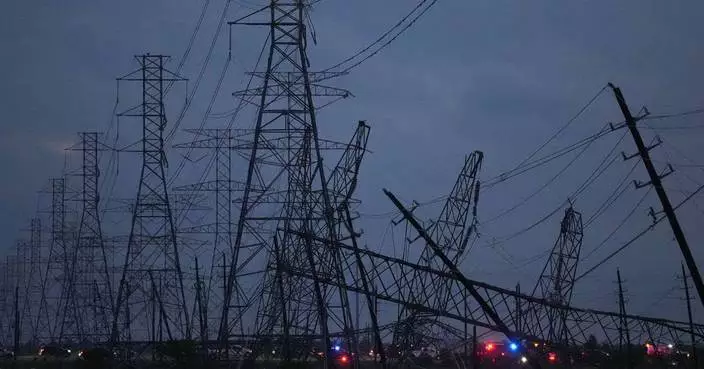SAN JUAN, Puerto Rico (AP) — A $62 million project to dredge Puerto Rico’s biggest and most important seaport began Wednesday amid fierce opposition from environmentalists.
Crews with California-based Curtin Maritime will remove nearly 3 million cubic yards (76 million cubic feet) of marine floor to open the San Juan Bay to larger vessels including tankers that will serve a new liquid natural gas terminal on Puerto Rico’s north coast.
The dredged material will be deposited into the Atlantic Ocean two nautical miles (four kilometers) north of the U.S. territory in a move approved by the U.S. Environmental Protection Agency, officials said.
Gov. Pedro Pierluisi said the project overseen by the U.S. Army Corps of Engineers is expected to give a $400 million boost to the local economy, adding that the dredging will be completed by October.
He dismissed concerns by environmentalists who have said the project would endanger wildlife and humans. “This already was authorized at all federal levels, including any environmental impact it might have,” he said.
In August 2022, the Arizona-based nonprofit Center for Biological Diversity filed a federal lawsuit against the U.S. government, saying the project threatens to destroy corals and seagrass beds and suck up turtles and other marine life.
The lawsuit is pending at a U.S. District Court in Washington, D.C., with a hearing last held in January.
“We are hoping for a decision soon,” Catherine Kilduff, an attorney for the Center for Biological Diversity, said in a phone interview.
“The dredging itself causes sediment that can kill corals,” she said. “Those corals have been impacted by diseases and warming waters, and so we’re worried that this dredging project…could be a death knell.”
Kilduff said the center also is concerned about manatees that swim in the San Juan Bay, where they depend on seagrass for food and are struck by ships.
She said the U.S. Army Corps of Engineers last dredged the bay in the early 2000s, promising they would plant an acre of seagrass.
“They still haven’t done that,” she said.
Kilduff noted that the federal government held a public comment period on the dredging project when Hurricane Maria struck Puerto Rico as a Category 4 storm in 2017, leaving the island without power or passable roads.
A USACE spokesperson did not immediately return a message seeking comment.
As the governor shared details about the project on Wednesday, a dredging vessel began operations in the background.
Officials said it would dig up to 46 feet (14 meters), with some areas in the San Juan Bay currently at depths ranging from 36 feet (11 meters) to 42 feet (13 meters).
“San Juan harbor is an economic engine and vital lifeline for Puerto Rico,” U.S. Army Corps of Engineers Col. Charles Decker said in the announcement. “It’s a phenomenal investment in the future of Puerto Rico.”
The Corps is investing almost $45 million in the project, with the government of Puerto Rico providing the rest.

FILE - A bird flies over the San Juan Bay Estuary in San Juan, Puerto Rico, Oct. 26, 2013. A $62 million project to dredge Puerto Rico's biggest and most important seaport began Wednesday, April 3, 2024 amid fierce opposition from environmentalists. Crews will remove nearly 3 million cubic yards of marine floor to open the San Juan Bay to larger vessels including tankers that will serve a new liquid natural gas terminal on Puerto Rico's north coast. (AP Photo/Ricardo Arduengo, File)
Since first grade, Julian Morris, 16, has changed schools six times, swinging between predominantly white and predominantly Black classrooms. None has met all his needs, his mother said.
At predominantly white schools, he was challenged academically but felt less included. At predominately Black schools, he felt more supported as a Black student, but his mother, Denita Dorsey, said they didn't have the same resources and academic opportunities.
Seventy years after the Supreme Court ruled separating children in schools on the basis of race was unconstitutional, Dorsey said the options available to her family in Michigan are disappointing.
“Segregation is abolished, sure, but our schools are still deeply divided along racial and socioeconomic lines,” Dorsey said. “It makes you think: It’s been 70 years but was it worth it?”
The 1954 Brown v. Board of Education ruling and desegregation orders were only the first steps toward the elusive goal of equitable education. For some Black families, school choice has been critical in finding the best available option. And that has not meant necessarily the school with the most racial diversity.
Integration alone is not what Black families have pushed for over the decades, said Bernita Bradley of the National Parents Union, an education advocacy group.
“We wanted integration with accountability and that’s not what we received,” she said. “That’s why choice needs to exist but we still need high-quality options.”
Dorsey made what she called a “contentious decision” in 2022, choosing Saginaw High School in Michigan, which is predominantly Black, over Julian's predominantly white charter school.
“I was challenged, and I had arguments with family. But Julian is now getting more support from his teachers and administration than he ever did at his previous schools,” she said.
The Brown decision is seen as a key impetus to kicking off the modern school choice movement. As many white families began turning to private schools as a way to avoid the court mandate, state lawmakers — primarily in Southern states — began launching school voucher programs.
In Prince Edward County in Virginia, which closed all its public schools in 1959 for five years to evade integration, state and local officials gave white families tuition grants and tax credits to attend private schools. No similar options were provided to Black families. The move inspired other states to adopt similar schemes before they were deemed illegal by the Supreme Court.
The arguments for school choice evolved over time.
Some thinkers in the 1960s such as Milton Friedman argued that giving families money to spend on education how they saw fit would revolutionize education, incentivizing schools to improve or be left behind. At the same time, civil rights leaders stressed that choice could equalize education for lower-income families, which overwhelmingly include Black and Hispanic students.
Today, some of the loudest advocates for vouchers no longer approach it as a way to push for social justice, said Claire Smrekar, a professor of education and public policy at Vanderbilt University. Rather, the focus is on parents' rights and lifting restrictions that may prevent wealthier families from using the programs at schools of their choice.
“This expansion is really extraordinary when you think about it,” Smrekar said. “There are no social justice arguments here for families trapped in poverty and zoned for low-performing schools. The new argument is that everyone should enjoy this subsidy.”
Meantime, conservative attacks on how topics related to race and racism are taught in schools have only added to the appeal of alternatives for some Black families. Some schools dedicate themselves to affirming students' Black heritage, claiming the mantle of freedom schools that started during the Civil Rights Movement in response to the inferior education Black Americans were receiving in the South.
“All parents want is a safe and caring environment where their child is going to go and they are going to be a partner in my child’s pathway to success,” Bradley said.
Black families also turned to homeschooling in large numbers during the pandemic, driven in part by a desire to shield their children from racism in classrooms and to better meet the individual academic needs of their children.
American schools are more racially diverse today compared to the era of Brown v. Board, but schools have been re-segregating, with lasting academic consequences. Schools where students of color compose more than 90% of the student body are five times more likely to be located in low-income areas, where students have worse educational outcomes.
According to research from Stanford University’s Educational Opportunity Project, the recent increase in segregation appears to be partially driven by school choice. In school districts where charter schools expanded most rapidly in the last two decades, segregation grew the most.
In Michigan, Julian said he thought his mother was “tripping or just going off the rails” to pull him out of a higher-ranked school.
“It wasn’t until I arrived at Saginaw High that I took a second look back and realized that what was said to me and things that happened at the school were not OK,” Julian said. “I was different there because I am Black. But now at Saginaw, it feels more welcoming and I feel included and supported. I feel the difference.”
Janel Jones, a mother of two children in Atlanta, said she has seen the benefits of choice, having sent her 13-year-old daughter and 17-year-old son to seven different schools combined. But just giving parents an option is not enough, she said.
“School choice is not choice if it is not equitable. At the end of the day, liberation directly affects our economic outcome, and as parents we have to make sure these educational systems are challenging academically but also meet their needs as members of society,” Jones said.
It is not as simple as sending children to an all-Black school, she said.
“Your child is protected, but also coddled. You have not learned how to understand and deal with microaggressions you are guaranteed to face when you get your first job. That’s the educational part we as Black parents also have to teach our kids and that’s not going to change any time soon,” she said.
AP journalists Sharon Lurye in New Orleans and Jeff Amy in Atlanta contributed to this report.
The Associated Press’ education coverage receives financial support from multiple private foundations. AP is solely responsible for all content. Find AP’s standards for working with philanthropies, a list of supporters and funded coverage areas at AP.org.

Janel Jones poses with her son, Christian Jones, 17, on Friday, May 17, 2024, in Lawrenceville, Ga. Jones, a divorced veteran in Atlanta with two children, said though she has seen the benefits of choice having sent her 13-year-old daughter and 17-year-old son to seven different schools combined across the country, she feels at though just giving parents an option is not enough. (AP Photo/Mike Stewart)

Janel Jones poses with her son, Christian Jones, 17, on Friday, May 17, 2024, in Lawrenceville, Ga. Jones, a divorced veteran in Atlanta with two children, said though she has seen the benefits of choice having sent her 13-year-old daughter and 17-year-old son to seven different schools combined across the country, she feels at though just giving parents an option is not enough. (AP Photo/Mike Stewart)

Denita Dorsey poses with her son Julian Morris, 16, in Saginaw, Mich., Thursday, May 16, 2024. (AP Photo/Paul Sancya)

Denita Dorsey poses with her son Julian Morris, 16, in Saginaw, Mich., Thursday, May 16, 2024. (AP Photo/Paul Sancya)














